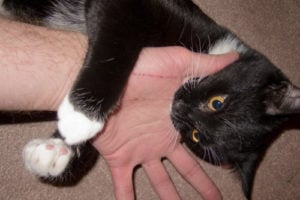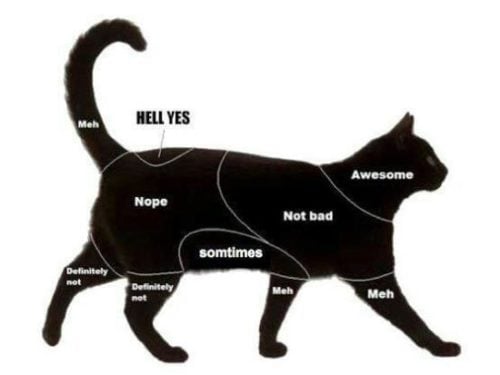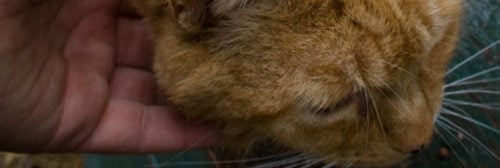
Petting-induced aggression is likely one of the most common aggressive cat behavior problems.
“My lovely angel was purring, sound asleep in my lap. I was petting her, and then, out of nowhere, that bloody devil bit my ****** hand!”
Andrea, a pet parent that is a regular at our vet clinic.
“Oh, excuse me, are you talking about one or two cats here?”
If this is your cat, you’ve come to the right place. In this article, you will learn why your cat bites when you pet him, what petting-induced aggression is, and how to stop a cat from biting your hand.
Petting-induced aggression is a scientific term, and its meaning is evident: it is aggression that is induced by petting. So, now we know that your cat bites you, or snarls at you, or hisses at you, because you are petting him.
Does your cat hate petting, then? No!
Your cat hates where it’s going. There are several theories as to why your cat attacks you while being petted; however, most agree that it’s because a threshold is reached, after which a cat no longer finds petting comfortable.
Your cat loves petting! Most cats do. It’s just that there are times when he thinks that enough is enough, and there are times when a certain spot on his body, like his belly or his back, is untouchable. What are those parts? This chart that is circulating the Internet illustrates those parts well:

We can discuss the validity of this illustration (it is an Internet joke, after all), but there is some truth in most of what you see here. Most cats like their head rubbed (particularly their cheeks, chin, and forehead), but they dislike having their rear part touched. And, most important…
Cats dislike petting of their bellies!
That is true. Unless your cat was hand-reared and is used to having his belly petted, bellies are usually off limits. Why? Because it’s the most vulnerable part of your cat’s body.
When your cat lies on the floor relaxed, it means that he trusts you. Does he want you to touch his belly? No! He’s not a dog; his trust level is slightly lower. While a dog trusts that you will rub his belly and won’t harm him, your cat trusts that you will not touch his belly.
Another common place where many cats dislike petting is their back. However, this dislike is usually associated with pain. If your cat does not like his back being petted, visit a veterinarian.
How do you stop petting-induced aggression in cats?
Now that we have covered some basics, it’s time to learn how to stop a cat from biting during the petting:
- Don’t punish your cat if he bites you. Ignore him. Remember, physical punishment teaches nothing. If your cat bites you, it’s not because of spite, or because he is mean. Something went wrong, and the solution is to find out what it was so that it doesn’t reoccur. If your cat bit you, keep calm and go away.
- Watch for signs before the biting occurs. Even if it seems to happen without warning, some signs are always present. Cats use their body as a communication tool all the time. Biting is usually prefaced by at least one of these signs: lashing of the tail, growling, ear folding, or twitching of the skin. Check here for a list of signs of cat aggression.
- Notice when and why signs of aggression appear. A moment when a cat displays signs of aggression during petting differs from cat to cat. Before correcting an unwanted behavior, you should find out under what conditions it occurs:
a) Cat bites after some time of petting. Try to notice how long is long enough.
b) Cat bites as you approach a certain spot on his body. It’s as simple as this: stop touching that spot and live with it. If you suspect the avoidance may be caused by pain, visit a veterinarian.
c) Cat bites as you try to pet him or her during a play. Don’t pet your cat while playing. Petting is relaxing, playing is activating. You should engage them at different times.
d) Cat bites as the owner enters the room. This is not petting-induced aggression. This is fear aggression. Find more information about settling a fearful cat down. - Stop petting before signs appear. It’s important to stop BEFORE, not WHEN, the signs mentioned above appear. If you want to work with your cat’s tolerance, you must ensure the petting is always pleasant. Going up to the point where your cat can no longer stand your hands will make him stressed. This applies no matter how your cat shows his intolerance to petting. If he likes it for three minutes, stop after two and a half. If he does not like you touching his belly, do all the other parts without approaching the undesired area. If your cat dislikes being petted at all, start by just sitting next to him, and make sure he feels comfortable being near you.
- Decide whether it’s necessary to go further. After you have established a good petting pattern without your cat biting you or showing any aggression, you need to decide whether it’s really necessary to move forward. At this point, you must have already made this procedure comfortable for the cat.If your cat does not like you touching his tail or belly, maybe this is the way it should be? If your cat starts biting you after three minutes of petting, maybe it’s totally okay with him being petted for
two and a half minutes? Just make the sessions more frequent throughout the day. Or try to make them gradually longer, and see how your cat responds. It’s all up to you. - Confirm that your cat is comfortable. Make sure your cat is totally okay with the amount of petting being received. That is, if he’s even a tiny bit stressed about it, you should decrease the amount. Take your time.

- Increase the amount of petting gradually. Now you can start gradually lengthening the petting sessions. If you can pet your cat for two and a half minutes, try three minutes. Watch carefully for any signs of aggression, as mentioned above. It’s good to stop before your cat bites you. If expressions of aversion (such as tail lashing, skin twitching, or ear folding) appear, step aside; do not make a fuss. Next time, return to the previous comfortable amount of petting and do not proceed so rapidly.If your cat is one of those that does not tolerate petting at all, but is now able to lie next to you peacefully, try a short (but not quick and nervous) rub on his chin or on the back of his head. Avoid making any rapid moves, though, and watch your cat’s body language. If you go too far and your cat bites you, take a break and return again later.
Keep this pattern, and be patient. You now know how to stop a cat from biting. Over time, your cat may become more tolerant, and the times when your cat bites your hand will be history. If your cat has other behavior issues, check our solutions to most common ones here.
Photos by: Pat Pilon, unknown author and Orin Zebest.
